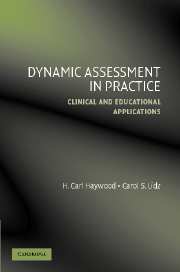Book contents
- Frontmatter
- Contents
- Preface
- Foreword, by Kenneth A. Dodge
- Foreword, by Thomas Oakland
- PART ONE THEORY AND PRINCIPLES
- PART TWO APPLICATIONS
- 4 Dynamic Assessment in Clinical Settings
- 5 Dynamic Assessment in Educational Settings
- 6 Applying Dynamic Assessment with Young Children
- 7 Applying Dynamic Assessment with School-Age Children
- 8 Applying Dynamic Assessment with Adults and Seniors
- 9 Writing Reports and Developing IEPs and Service Plans with Dynamic Assessment
- 10 Unresolved Issues, Conclusions, and Recommendations
- APPENDIX A TESTS REFERRED TO IN THE TEXT THAT DO NOT BELONG TO THE AUTHORS
- APPENDIX B SOURCES OF DYNAMIC ASSESSMENT MATERIALS
- References
- Author Index
- Subject Index
- Tests and Testing Materials Index
7 - Applying Dynamic Assessment with School-Age Children
Published online by Cambridge University Press: 04 December 2009
- Frontmatter
- Contents
- Preface
- Foreword, by Kenneth A. Dodge
- Foreword, by Thomas Oakland
- PART ONE THEORY AND PRINCIPLES
- PART TWO APPLICATIONS
- 4 Dynamic Assessment in Clinical Settings
- 5 Dynamic Assessment in Educational Settings
- 6 Applying Dynamic Assessment with Young Children
- 7 Applying Dynamic Assessment with School-Age Children
- 8 Applying Dynamic Assessment with Adults and Seniors
- 9 Writing Reports and Developing IEPs and Service Plans with Dynamic Assessment
- 10 Unresolved Issues, Conclusions, and Recommendations
- APPENDIX A TESTS REFERRED TO IN THE TEXT THAT DO NOT BELONG TO THE AUTHORS
- APPENDIX B SOURCES OF DYNAMIC ASSESSMENT MATERIALS
- References
- Author Index
- Subject Index
- Tests and Testing Materials Index
Summary
In this chapter, we go beyond the general model of psychological assessment to discuss how this model can be applied in schools. Assessment in schools or in relation to the school curriculum should be integrated with information from multiple sources, all of which impinge on students' ability to learn and profit from instruction. Increasingly, teachers are asked to address individual needs of children with very diverse backgrounds and needs. If teachers are expected to assume this increased responsibility, then those who provide supportive services to the teachers must address these demands as well.
One of the primary contributions of dynamic assessment in educational settings is the provision of information that optimizes the match between students and the tasks they are asked to perform. In this chapter, we look at dynamic assessment as a source of information that facilitates the ability of instructional settings to meet the needs of individual learners, the ability of assessors to provide information that is usefully and meaningfully applied in educational settings, and the ability of learners to function successfully in educational settings. Dynamic assessment also becomes a tool that addresses the call for information about students' responsiveness to intervention rather than restricting outcomes of assessments to provision of recommendations for placement, referrals, or diagnostic labels. Dynamic assessment is, after all, defined by its interactive nature and its ability to look directly at the responsiveness of learners to interventions that are offered during the course of the assessment.
- Type
- Chapter
- Information
- Dynamic Assessment in PracticeClinical and Educational Applications, pp. 176 - 204Publisher: Cambridge University PressPrint publication year: 2006



